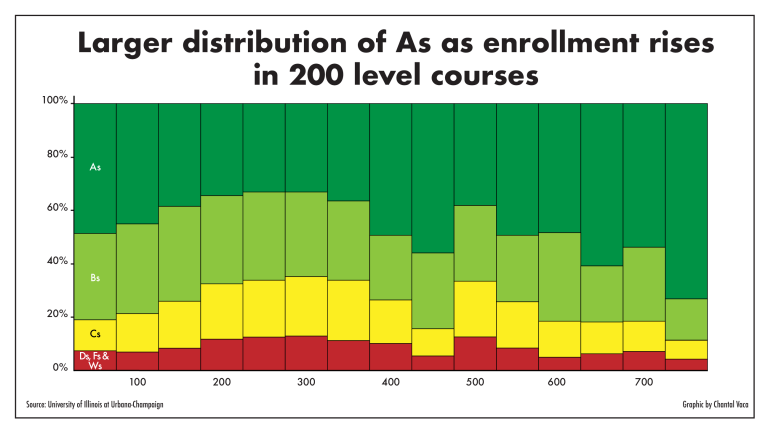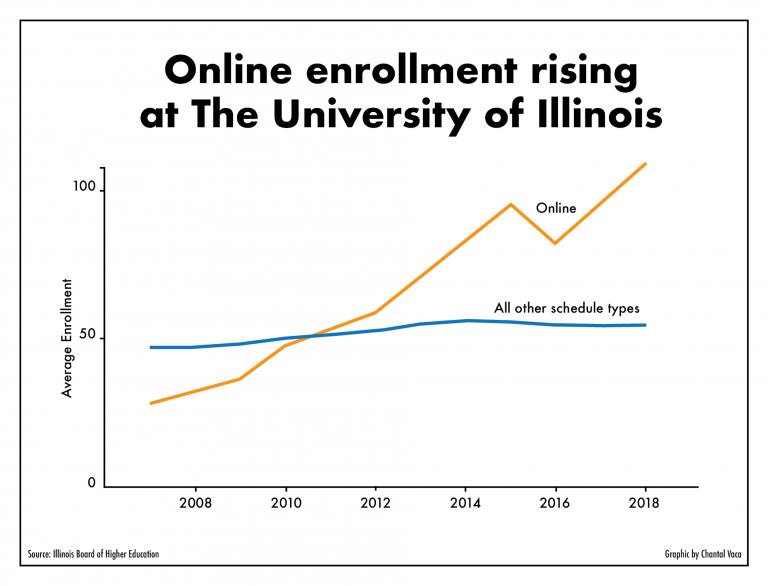
58% of all grades at UI were A’s in 2018
It’s finals week at the University of Illinois. Students nose-deep in textbooks cram into every available space of campus libraries, including the Undergraduate Library, where three juniors huddle around a table plastered with notes and papers, each looking intently at laptop screens.
Nini Sulaiman, Carmen Carteno and Adrian Hernandez have been there for many hours, and it will be many more before they leave. Sulaiman, a psychology and kinesiology major, is fresh off of an all-nighter and plans to do another tonight. Hernandez, a chemistry major with a final coming in two days, plans two of his own back-to-back all-nighters. They and Carteno care about grades. All have GPAs of 3.2.
Little do they know — all-nighters or not — that well more than half of all course grades given at UI last year were A’s, and the percentage has been rising for more than a decade.
In 2018, a total of 58% of UI course grades were A-, A or A+, according to data obtained through a Freedom of Information Act request. Thirteen years ago, only 45% of course grades were in the A range.




“Not surprised,” was the reaction of Kevin Pitts, vice provost for undergraduate education.
Grade inflation — higher grades for work that formerly would not have merited them — has impacted campuses nationwide, according research done by former Duke University professor Stuart Rojstaczer and collected on his website, gradeinflation.com.
“Do we have it? Probably we do,” Pitts said.
Pitts contends that grade inflation is a complex issue that is not easy to assess, but a four-month analysis of more than 13 years of UI grading data uncovered two main factors associated with higher grades: big courses and online courses.
In 2018, 72.3% of grades in online courses at UI were A’s. This compares to only 54.4% of grades in all other course types.
"Do we have it? Probably we do."
When proposing permanent adoption of its online-only winter term in 2015, UI officials produced a report finding no statistically significant difference between grading in online courses and the same courses taught face to face. However, they noted that the courses selected were the large, popular ones — courses that already tend to have higher grades.
Online or face-to-face, according to the data, the percentage of A’s awarded increases almost steadily with class size, particularly with classes of 350 or more students and especially in introductory, 100-level courses.
“I’m not surprised that the fraction of A’s in larger courses tend to be higher, because the larger courses tend to be at the 100 level, introductory courses,” Pitts said.




In 2005, the average GPA for all courses at UI was 3.21. By 2018, it had risen 3.38.
Grade inflation isn’t limited to UI.
At the University of North Texas, researchers R. Todd Jewell, Michael A. McPherson and Margie A. Tieslau examined data from UNT and found “inflation may result from national or regional trends in competition for students and public funding formulas.”
They warned that their university might find it counterproductive to actively discourage grade inflation.
The chicken or the egg?
Whether courses become large because they are “easy” or become “easy” because they are large is unknown. What’s clear from social media sites such as Reddit and Facebook and study-aid sites such as Quizlet is that larger courses increase chances for students to find resources such as past quizzes, test answers, homework and other materials online. They also may offer fewer controls to prevent those resources from being used.
Online and large courses also are among the most profitable for university colleges to teach.
Although online courses represent a minority of all UI courses, their share of overall courses has doubled in less than a decade, rising to 5.6% in 2017-’18, according to data obtained from the University’s Division of Management Information.
“If you’ve got a thousand people who need to take microeconomics this semester, what’s the most cost-effective way to do it?” Pitts said. “Put them in Foellinger and in a room that can hold them all and teach them all at once.”
And when a course is big enough for Foellinger, it becomes a strong candidate for conversion to online.



I completely resolved my question when I read this post, thanks to the author for the very detailed description. I wrote my review on the https://paperwritingservices.reviews/, you can go in and read. Thank you very much for your attention in your time.